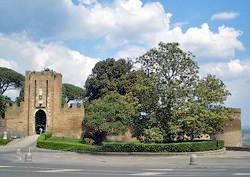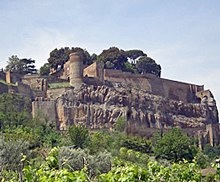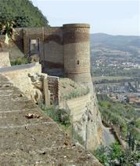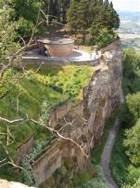


The public park of Orvieto was the site of a succession of fortresses.
Earliest Fortifications
The first documented fortress on this site was destroyed in 1342. It is worth recounting the series of events that led to its demise, and those that followed it, because they explain why Rocca dell’ Albornoz was so significant. The death in 1337 of Ermanno Monaldeschi della Cervara is a good place to begin because his three-year tyranny brought a short period of peace that punctuated the civil war that had gripped the city for decades. He ended all pretence of popular government and the only question after his death was which particular faction of the warring Monaldeschi family would rule the city.
In 1338, after months of indecisive conflict, the faction leaders agreed to go into exile:
-
✴The Monaldeschi della Vipera broke the agreement, took the city and were subsequently known as the "Malcorini" (from "di mal core" or “of bad heart”).
-
✴The Monaldeschi della Cervara honoured it, went into exile and were consequently known as the "Beffati" (from “beffare”, which means to make a fool of).
Matteo Orsini, an ally of the Malcorini, was appointed as Capitano del Popolo in 1341 and installed as Lord of Orvieto after a popular uprising soon after. The Beffati made a concerted attempt to retake the city in 1342, and although they failed, they succeeded in destroying the fortifications on this site.
Orvieto now endured a long period of civil war and other disasters. The papal rector, Nicolò della Serra managed to unite the warring factions of Orvieto in 1352. However, the city soon fell to Archbishop Giovanni Visconti of Milan, who installed Giovanni di Vico as Lord of Orvieto. He established a garrison of some 250 soldiers at San Lorenzo delle Vigne to protect the city.
Rocca dell’ Albornoz (1364-70)

The fortress that was subsequently built on this site was named for the papal legate, Cardinal Gil Albornoz, who had landed in Italy from Avignon in 1353, intent upon reasserting papal control in Italy. His first target was the Patrimony, and in particular the expulsion of Giovanni di Vico from Viterbo and Orvieto.
Papal forces under the Capitano del Patrimonio, Giordano del Monte degli Orsini assembled at Corbara: this castle outside Orvieto that belonged to Conte Ugolino I di Montemarte, who had entered papal service in 1353. When the papal army seized the garrison at San Lorenzo delle Vigne, Giovanni di Vico led a company of cavalry out of Orvieto to try to retake it. This action failed, and Giovanni di Vico was lucky to escape with his life. He finally abandoned Orvieto in May 1354 and took refuge in Viterbo. Threatened there by insurrection and by the advance of papal forces from Rome, he finally conceded defeat.
It is likely that the ruined city fortress and the fortifications at San Lorenzo delle Vigne were restored to some extent in 1354, and that Ugolino da Montemarte (who emerged as a leading military architect) played a part in this. However Giordano Orsini judged Orvieto to be an inappropriate place from which to administer the patrimony because it lacked secure accommodation. When the mercenary Hanneken (Johannes, Anichino) Baumgarten menaced the city in 1364, Albornoz sent Giordano Orsini and Ugolino da Montemarte to strengthen its defences. A document in the archives of Orvieto records that work began in September 1364, at the expense of the Commune and under the supervision of Ugolino di Montemarte. (It was probably at this point that the ancient parish church of San Martino was demolished). Masons and carpenters working on the site were sent to Viterbo in 1367 to inspect its “anteportum cum ponte levatorio” (front entrance with drawbridge), which was replicated at Orvieto. The work seems to have been completed by 1370.
Matteo di Giovannello, il Gattapone is recorded in Orvieto in 1373, when he advised on the construction of a second fortress near Porta Maggiore. However, this was never built.
Later History
The newly elected Pope Urban VI appointed Rinaldo Orsini as governor of Orvieto in 1378. However, in 1380, Orsini declared for the anti-Pope Clement VII. He installed a company of Clement VII's Breton mercenaries in the city and exiled the Beffati. Some 3,000 people died in the subsequent bloodshed. Troops of Urban VI sacked the contado in 1387 but they were unable to take the city.
Rinaldo Orsini was murdered in 1390 and this led to Orvieto’s return to the Roman obedience after a terrible siege. Urban VI's successor, Pope Boniface IX negotiated a truce between the Malcorini and Beffati, and Luca Monaldeschi della Cervara became the papal governor. He drove the remnants of the Breton mercenaries from the Rocca dell’ Albornoz, almost destroying it in the process. The troops of Clement VII retook the city a year later and installed Biordo Michelotti of Perugia as Signore.
This regime lasted until 1398 when the devastated city once more entered the Roman obedience. Boniface IX installed his brother, Giovanni Tomacelli as lord of Orvieto in the period 1398-1404 and he began to repair the fortress. It subsequently became the residence of a two, non-papal usurpers:
-
✴King Ladislas of Naples in 1414; and
-
✴Braccio Fortebracci, from 1416 until 1419 (when Pope Martin V forced him to abandon it).
The end of the papal schism and the return of Martin V to Rome stabilised central Italy for a time.
The situation in Italy deteriorated when Pope Eugenius IV (1431-7) came into conflict with the powerful Duke Filippo Maria Visconti of Milan. He sent the condottiere Francesco Sforza into the Papal States in 1433 to harass Eugenius IV, whereupon Sforza used the opportunity to carve out a territory for himself in the Marches. He changed sides in 1434 and the infuriated Filippo Maria Visconti sent another condottiere, Nicolò Piccinino to drive him from the Marches. Piccinino, who also had ideas of founding his own state, entered Orvieto in April 1434 with the assistance of the Beffati, expelled the Mercorini, and was proclaimed Lord of Orvieto. Sforza besieged and then took the city in 1435 and installed the Malcorini Gentile and Arrigo Monaldeschi della Vipera as Lords of Orvieto.
After these convulsions, the citizens took the opportunity to demolish what was left of the hated Rocca dell’ Albornoz and peace returned to Orvieto for the first time in a century.
Design of Rocca dell’ Albornoz
The floor plan of Rocca dell’ Albornoz still survives. It was broadly rectangular, with a "palazzetto" to the right of the entrance and smaller buildings distributed around the outer walls. It towered over Porta Soliano (below and to the right in the illustration above), which became known as Porta della Rocca. The fortress was protected by a moat with two drawbridges (the opening to the second of which is behind the trees in the photograph at the top of the page).
New Fortress (1450-70)
In 1449, the Beffati killed Arrigo Monaldeschi and drove Gentile from the city, which now settled down to its fate as a papal possession under Pope Nicholas V. By this time, the population had fallen by more than a half from its peak in the 13th century.


From this point, the fortress fell gradually into a state of disrepair, despite the restoration in 1658 by Pope Alexander VII that is recorded by the inscription over the entrance. However, it suffered no particular mishaps, even during the Napoleonic period.
Orvieto returned to papal control in 1816 and Pope Gregory XVI elevated it to the seat of the Apostolic Delegation (papal provincial government) in 1831. The fortress was largely demolished at that point and the interior was laid out as an amphitheatre for public spectacles. An official ceremony was held here in 1882 to mark the death of Giuseppe Garibaldi. The moat was finally filled in in 1888 as part of the works to install the funicular railway and the area was subsequently laid out as a public park.

